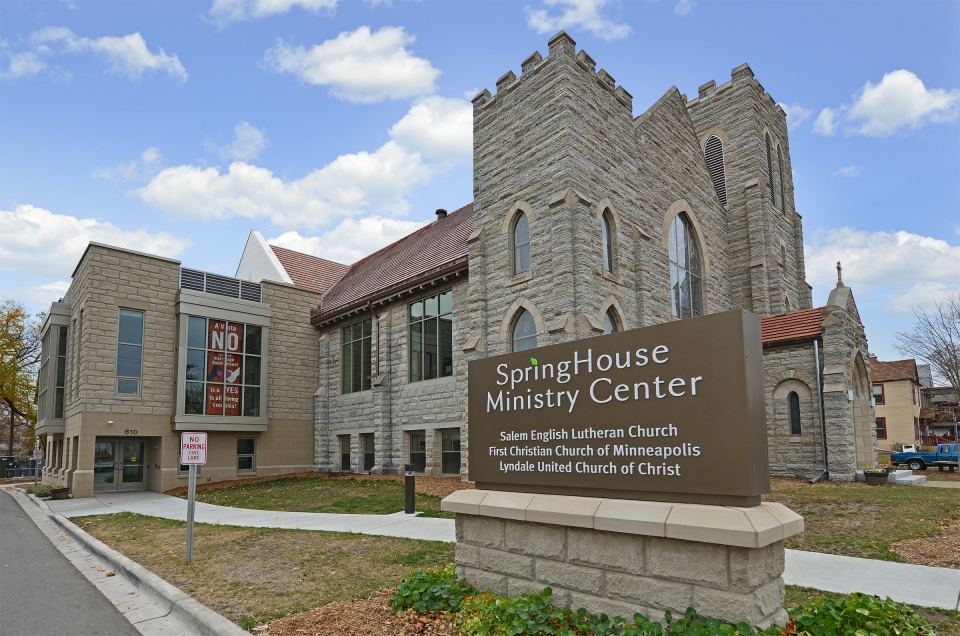Moving in With the Neighbors
Moving in With the Neighbors
By Caleb Rollins
It’s a familiar story for all too many congregations in North America. Their membership ages and declines at the same time their building ages and declines. They struggle to discern how to best care for the decaying facility that houses a majority of their ministries. Maybe they could attempt a capital campaign, apply for grants or financing, or decide to release their property assets in support of one of their ministry partners. Or maybe they could move in with the neighbors.
That’s the path taken by Salem English Lutheran Church, Lyndale United Church of Christ, and First Christian Church (Disciples of Christ) in south Minneapolis, who worship and serve in their shared space known as SpringHouse Ministry Center. The intertwining of their journeys began in 2004, when Salem was struggling to keep the lights and heat on in their old building at the corner of 28th Street and Lyndale Avenue in the Whittier neighborhood. Instead of choosing to close down their ministry entirely, they decided to partner with nearby Lyndale UCC, a congregation with a similar commitment to justice and equity in the neighborhood. In 2006, Salem moved in with Lyndale UCC but retained ownership of their old property. Together with Lyndale UCC, they plotted how they might collectively invest in the neighborhood through the use of Salem’s former building and land. After seven years of partnership, Lyndale sold its own decaying building, and the two congregations moved into a nearby arts center. Meanwhile, Salem and Lyndale UCC had connected with First Christian, another neighborhood congregation with similar values who was facing challenges in sustaining an old building. In 2011, these three congregations formally agreed to work together and share space in the soon-to-be renovated old building of Salem.
According to current Lyndale UCC minister, Rev. Rebekah Voekel, each congregation committed a little over $1 million to the restoration of the old Lutheran sanctuary. First Christian had sold their building to a local arts institution, while Lyndale opted to sell to a local congregation of mostly African immigrants. Salem retained ownership of the original sanctuary building but sold an addition to a developer who built sixty-three affordable housing units on the site. With this infusion of cash, the three congregations could renovate one of the existing buildings to fit the needs of three churches simultaneously.
Their new shared space included woodwork from the old First Christian building and ceiling beams made from the old pews of Salem’s original sanctuary, and it offers three distinct worship spaces. However, the congregations rotate seasonally around these areas. “We don’t stay in one worship space so that we can’t claim that it’s ours and get too comfortable and start to decline again,” says First Christian senior pastor, Rev. Dr. Laurie Pound-Fielle. In addition to these shared worship spaces, the congregation’s commitment to the neighborhood shines through in the use of the building throughout the week by various community groups.
The congregations share more than just their space. They also gather together for their children’s and youth ministries and even celebrate baptisms collectively. According to Pound-Fielle, this not only solved a practical problem of small numbers of children in each congregation but also embodied innovative practices of church for young people. “It brought more energy and a different understanding for the children and the youth of what church could be.”
While this partnership has energized each congregation, it has not come without challenges. The sharing of ministries between faith communities of different denominations has inevitably led to some friction from various cultural differences. The commitment to shared space also means that each congregation must plan to use spaces with intentionality rather than assuming a room will be empty because their congregation doesn’t have an event planned.
Ultimately though, this unique partnership model allows each congregation to maintain its own identity while sharing the material resources that so often become barriers to financial sustainability. Through moving in together, the congregations of SpringHouse Ministry Center have provided a potential pathway for other congregations to remain practicing their ministries of love and grace in their communities.
This story is part of Lake Institute’s story collection, the Faithful Generosity Story Shelf, which highlights congregations and other religious organizations who have sought to use their assets and resources in creative—and sometimes surprising—ways as an expression of faithful giving.
Each entry in our Story Shelf is short enough to be read and discussed during a committee meeting or other group gathering. Our hope is that these accessible vignettes will spark new questions, conversation, and imagination among clergy and laity about what might be possible with the funds, buildings, land, and other resources in their care. If you know a story that should be included in the Story Shelf, suggest it here.
Subscribe
Insights, a bi-weekly e-newsletter, is a resource for the religious community and fundraisers of faith-based organizations that provides:
- Reflections on important developments in the field of faith and giving
- Recommended books, studies and articles
- Upcoming Lake Institute events

